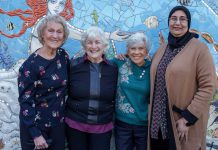Don’t expect to take a dip at the Gilroy Hot Springs next
weekend
– at least not yet.
Don’t expect to take a dip at the Gilroy Hot Springs next weekend – at least not yet.
Warm, rejuvenating water still spills out of a natural sulfur spring after more than 40 years of abandonment, but the piping and infrastructure are long gone and there’s much work to be done before soak-seekers can return to the historic gem tucked away in Henry W. Coe State Park just east of Gilroy. The outdoor relic will open for just one day this month thanks to volunteers and park employees who have spent weekends during the past year refurbishing the once-renown site.
Hotels, restaurants, tubs, redwood cabins, and gambling and dance halls once beckoned everyone from hunters to flappers, but the revelry began to fade in the 1960s after more than 100 years. The property passed through many hands – including a foreign developer – before closing down in 1967 due to safety and sanitation issues. The state parks department acquired it in 2003 after time and fires had returned it to nature and volunteers have been working with the blessing of State Parks Superintendent Eddie Guaracha.
“There’s a lot of hope for the site,” said Laura Dominguez-Yon, a volunteer with the nonprofit Friends of Gilroy Hot Springs. The organization, founded last summer, coalesced the Gilroy Historical Society, the Gilroy Museum, and dozens of people from far and near who – like Dominguez-Yon – once lived on the remote site. As most of the “friends” are elderly or live out of town, the group has turned to park employees, Boy Scout Troop 792 and students from Anzar High School in San Juan Bautista, among others, to clear truckloads of prickly overgrowth and voracious vines that – along with vandalism – have strangled the 20 or so buildings Dominguez-Yon grew up around.
“Welcome to my first home. Please wipe your feet,” is how she plans to begin her walking tour May 16 at the historical landmark, she said.
Growing up, Dominguez-Yon lived there with her parents thanks to H. K. Sakata, a Japanese-American who bought the property in 1938. Sakata acquired the site from Florence Mabery, the granddaughter of George Roop, who first developed the property along with William Oldham after the Civil War. Dominguez-Yon – who has made contact with Mabery’s and Sakata’s descendants – and her family moved to the Japanese-centric hostel after World War II along with 60 other Japanese-American families who had been removed from the West Coast during the war, she said. There’s a popular rumor that the individual who bombed Pearl Harbor actually stayed at the Hot Springs once, she said.
By the late 1960s, though, health officials concerned with the hygiene of mineral wells and other unsanitary conditions at the isolated enclave effectively put the site into hibernation for the last quarter of the 20th century. An earthquake fault line also runs beneath the mile-long gravel path that snakes through this quiet corner of Henry Coe, but with septic tank technology, satellites and solar energy, Dominguez-Yon said the friends are confident a caretaker or park ranger will live on site one day and welcome residents looking for a splash.
“Our ultimate dream is to reopen the mineral wells so we can have soaking again … And we’d like to get the pool reopened,” she said in reference to a sand-filled cavity in the ground outside an old cinder block dressing room that people see when they first enter the site at the end of Hot Springs Road, which is 13 miles and about 45 minutes from Gilroy by car.
“It’s so close yet so far away from the hectic Silicon Valley lifestyle. It has serenity,” Dominguez-Yon said. “And you notice your skin is softer after touching the water, too.”
How the Hot Springs got to this point
1865 – Jose Quintin and Ignacio Maria Ortega acquire property in Mexican land grant.
1866 – George Roop and William Oldham begin developing hotels, restaurants, cabins, soaking tubs and other attractions.
1938 – H.K. Sakata purchases property and later creates hostel for Japanese-Americans leaving WWII internment camps.
1950-60s – Business surges until health concerns and deed transfers effectively shut down regular public visits.
2003 – Henry W. Coe State Park acquires property.
2008 – Friends of Gilroy Hot Springs founded as part of the Pine Ridge Association.
May 16, 2009 – Nonprofit to host displays, tours and more at the site, 8 a.m. to 5 p.m., for $5 for adults and free for children younger than 12; the site is at the end of Gilroy Hot Springs Road.
Reservations and more information: 314-7185, (925) 837-1024 or in**@***********************gs.org
Note: Visitors are asked to bring a picnic lunch; parking is limited and volunteers are still needed.














